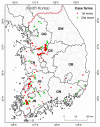Spatiotemporal Dynamics of Highly Pathogenic Avian Influenza Subtype H5N8 in Poultry Farms, South Korea
- PMID: 33579009
- PMCID: PMC7916766
- DOI: 10.3390/v13020274
Spatiotemporal Dynamics of Highly Pathogenic Avian Influenza Subtype H5N8 in Poultry Farms, South Korea
Abstract
Highly pathogenic avian influenza (HPAI), a zoonotic disease, is a major threat to humans and poultry health worldwide. In January 2014, HPAI virus subtype H5N8 first infected poultry farms in South Korea, and 393 outbreaks, overall, were reported with enormous economic damage in the poultry industry. We analyzed the spatiotemporal distribution of HPAI H5N8 outbreaks in poultry farms using the global and local spatiotemporal interaction analyses in the first (January to July 2014) and second (September 2014 to June 2015) outbreak waves. The space-time K-function analyses revealed significant interactions within three days and in an over-40 km space-time window between the two study periods. The excess risk attributable value (D0) was maintained despite the distance in the case of HPAI H5N8 in South Korea. Eleven spatiotemporal clusters were identified, and the results showed that the HPAI introduction was from the southwestern region, and spread to the middle region, in South Korea. This spatiotemporal interaction indicates that the HPAI epidemic in South Korea was mostly characterized by short period transmission, regardless of the distance. This finding supports strict control strategies such as preemptive depopulation, and poultry movement tracking. Further studies are needed to understand HPAI disease transmission patterns.
Keywords: H5N8 subtype; South Korea; Spatiotemporal analysis; avian influenza.
Conflict of interest statement
The authors declare no conflict of interest.
Figures





Similar articles
-
Risk factors associated with highly pathogenic avian influenza subtype H5N8 outbreaks on broiler duck farms in South Korea.Transbound Emerg Dis. 2018 Oct;65(5):1329-1338. doi: 10.1111/tbed.12882. Epub 2018 Apr 19. Transbound Emerg Dis. 2018. PMID: 29673109
-
Multiple Reassortants of H5N8 Clade 2.3.4.4b Highly Pathogenic Avian Influenza Viruses Detected in South Korea during the Winter of 2020-2021.Viruses. 2021 Mar 16;13(3):490. doi: 10.3390/v13030490. Viruses. 2021. PMID: 33809549 Free PMC article.
-
Spatio-temporal patterns of highly pathogenic avian influenza virus subtype H5N8 spread, France, 2016 to 2017.Euro Surveill. 2018 Jun;23(26):1700791. doi: 10.2807/1560-7917.ES.2018.23.26.1700791. Euro Surveill. 2018. PMID: 29970219 Free PMC article.
-
Epidemiology and pathobiology of H5Nx highly pathogenic avian influenza in South Korea (2003-2024): a comprehensive review.Vet Q. 2025 Dec;45(1):23-38. doi: 10.1080/01652176.2025.2498918. Epub 2025 May 7. Vet Q. 2025. PMID: 40332021 Free PMC article. Review.
-
[Avian influenza: eradication from commercial poultry is still not in sight].Tijdschr Diergeneeskd. 2004 Dec 1;129(23):782-96. Tijdschr Diergeneeskd. 2004. PMID: 15624878 Review. Dutch.
Cited by
-
Impact of inland waters on highly pathogenic avian influenza outbreaks in neighboring poultry farms in South Korea.J Vet Sci. 2022 May;23(3):e36. doi: 10.4142/jvs.21278. J Vet Sci. 2022. PMID: 35618317 Free PMC article.
-
Risk Prediction of Three Different Subtypes of Highly Pathogenic Avian Influenza Outbreaks in Poultry Farms: Based on Spatial Characteristics of Infected Premises in South Korea.Front Vet Sci. 2022 May 31;9:897763. doi: 10.3389/fvets.2022.897763. eCollection 2022. Front Vet Sci. 2022. PMID: 35711796 Free PMC article.
-
Epidemiology and Evolutionary Dynamics of High Pathogenicity Avian Influenza (HPAI) H5N1 in Bangladesh.Transbound Emerg Dis. 2023 Jul 12;2023:8499018. doi: 10.1155/2023/8499018. eCollection 2023. Transbound Emerg Dis. 2023. PMID: 40303694 Free PMC article.
-
Epidemiologic and import risk analysis of Peste des petits ruminants between 2010 and 2018 in India.BMC Vet Res. 2022 Nov 29;18(1):419. doi: 10.1186/s12917-022-03507-x. BMC Vet Res. 2022. PMID: 36447274 Free PMC article.
-
Ecological drivers for poultry farms predisposed to highly pathogenic avian influenza virus infection during the initial phase of the six outbreaks between 2010-2021: a nationwide study in South Korea.Front Vet Sci. 2023 Dec 7;10:1278852. doi: 10.3389/fvets.2023.1278852. eCollection 2023. Front Vet Sci. 2023. PMID: 38130434 Free PMC article.
References
-
- Jeong J., Kang H.-M., Lee E.-K., Song B.-M., Kwon Y.-K., Kim H.-R., Choi K.-S., Kim J.-Y., Lee H.-J., Moon O.-K. Highly pathogenic avian influenza virus (H5N8) in domestic poultry and its relationship with migratory birds in South Korea during 2014. Vet. Microbiol. 2014;173:249–257. doi: 10.1016/j.vetmic.2014.08.002. - DOI - PubMed
Publication types
MeSH terms
LinkOut - more resources
Full Text Sources
Other Literature Sources
Medical

